#majid hosseini
Text


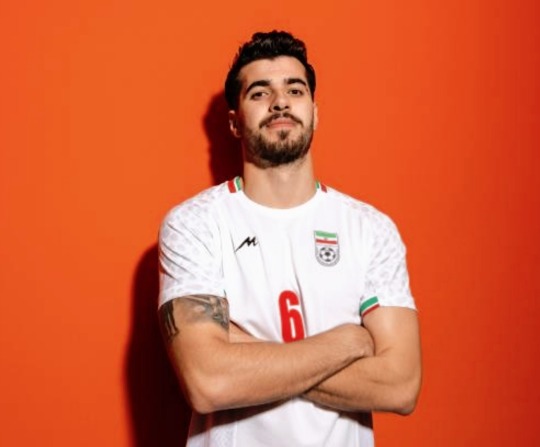




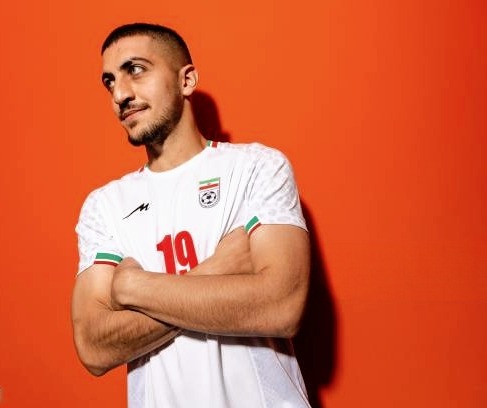


Iran NT official portraits for Qatar 2022.
#we might not be the best team but at least we're still the best looking team#iran nt#team melli#iran national football team#alireza jahanbakhsh#amir abedzadeh#saeed ezatolahi#milad mohammadi#sardar azmoun#ramin rezaeian#majid hosseini#sadegh moharrami#mehdi taremi#abolfazl jalali#i wish i could post them all#تیم ملی فوتبال مردان ایران
11 notes
·
View notes
Text
Iran World Cup squad 2022: Final list of 26 players for national team in Qatar

#FIFA World Cup Qatar 2022#Iran World Cup squad#Final list of 26 players#Goalkeeper#Alireza Beiranvand#Hossein Hosseini#Payam Niazmand#Amir Abedzadeh#Defender#Ramin Rezaeian#Abolfazl Jalali#Hossein Kananizadegan#Shoja Khalilzadeh#Mortza Pouraliganji#Majid Hosseini#Sadegh Moharrami#Milad Mohammadi#Ehsan Hajisafi#Midfielder#Saeid Ezatolahi#Ahmad Nourollahi#Ali Karimi#Rouzbeh Cheshmi#Vahid Amiri#Mehdi Torabi#Alireza Jahanbakhsh#Ali Gholizadeh#Saman Ghoddos#Forward#Sardar Azmoun
0 notes
Text
There is not much News coming out of Iran.
@bellamonde @aftabkaran are not active. @edentheactivist 's Tumblr got deactivated. Previously, they used to post regular Updates regarding the situation and developments in Iran.
Probably Internet is completely shut down.
I hope all are alive and well.
Again, I will share the Names of people who were announced to be sentenced to Death, but were not at that time.
I request you to Reblog.
Mohammad Ejma
Mohammad Pasandian
Sajjadimannejad
Mehdisannefarshi
Hazharhamidi
Alirezakafaei
Miladarmoun
Elahe Mohammadi
Niloofar Hamedi
Shoaib Mir Baloch Zehi Rigi
Mohammad Ghobadloo
Mohammad Qobadloo
Ebrahim Naroui
Toomaj Salehi
Farnoush Esmi
Benjamin Gaffari
Mohammad Boroughani
Ayoub Jamal
Mohammad Soltani
Mojgan Valian Zadeh
Jalil Azizpour
Alan Veysi
Bahaledin Veysi
Javad Rouhi
Elham Modaressi
Ava Jahangiri
Paria Faramarzi
Shahin Samadpour
Hamid Gharehasanlou
Farzaneh Gharehasanlou
Manouchehr Mehman-Navaz
Akbar Ghafari
Ebrahim Rigi
Mohsen Rezazadeh Qaraqualou
Saman Yasin
Seyed Mohammad Hosseini
Parmida Mehdipour
Farhad Tahazadeh
Farzad Tahazadeh
Sahand Noor Mohammadzadeh
Mehdi Keshvari
Hossein Hajlou
Abol Fazl Mehri
Hossein Mohammadi
Raha Ajoudani
Arin Farzania
Armin Mehdi Shokrollahi
Amir Mehdi Jaffari
Mahan Sadrat
Saeed Shirazi
Hajar Hamidi
Reza Eslamdoost
Karvan Shahiparvaneh
Shahram Marouf-Moula
Saeed Yaghoubi
Saleh Mir Hashemi
Amir Nasr Azadani
Mohsen Sohrabi
Makan Davari
Majid Kazemi
Hassan Firouzi
Farnaz Alizadeh
Niloufar Shakeri
Soheila Hijab
Hasti Ofogh
Samaneh Fathi
Shaker Behrouz
Parham Parvari
Saman Sayeedi
Elham Shoukdar
Zahara Hamedani
Navab Ebrahimi
Keyvan Mohtadi
Ehsanpirbarnash
Poryajavaheri
Ebrahim Naroui
Mehdi Mohammadi Fard
Mansour Dahmardeh
Kambiz Khorvat
Arshia Takdastan
Vajihe Pari Zanganeh
Amirsartipi
Zahra Nabizadeh
Hossein Ekhtarian
Mohammad Ekhtarian
Amir Mohammad Jafari
Maryam Haqgou
Shahla Abdi
Women. Life. Freedom
Freedom for Iran
Please share.
Please reblog.
#Iran#Iranian Revolution#Women Life Freedom#Jin Jiyan Azadi#Zan Zendagi Azadi#Mahsa Amini#Jina Amini#Say her Name#Fereshteh Ahmadi#Nika Shakarami#Kian Pirfalak#Mohsen Shekari#Majid Reza Rahnavard#Mehdi Karami#Mohammad Hosseini#Say their Names#Remember their Names#Stop Executions In Iran#Release all prisoners in Iran#Help Iran#Save Iran#Free Iran#Freedom for Iran#UN#Useless Nations
238 notes
·
View notes
Text
Soi kèo Iran vs Qatar lúc 22h00
Iran và chủ nhà Qatar sẽ gặp nhau ở trận bán kết thứ hai của Asian Cup 2023.
Soi kèo Châu Á Iran vs Qatar chính xác từ Xoilac
Iran tham gia giải đấu với tư cách là đội có thứ hạng cao thứ hai trong khu vực AFC sau Nhật Bản và đã thi đấu đạt được kỳ vọng cho đến nay. Họ đã vượt qua vòng bảng với thành tích bay bổng khi là một trong hai đội duy nhất toàn thắng cả ba trận đấu vòng bảng. Team Melli đã khởi động chiến dịch Asian Cup của mình bằng chiến thắng thuyết phục 4-1 trước Palestine và tiếp theo là chiến thắng 1-0 trước Hồng Kông và chiến thắng 2-1 trước Các Tiểu vương quốc Ả Rập Thống nhất.
Ở vòng loại trực tiếp, họ bị Syria cầm hòa 1-1 nhưng vượt qua được đối thủ khó nhằn này ở loạt sút luân lưu. Tuy nhiên, màn trình diễn tốt nhất chắc chắn của họ là ở trận tứ kết khi họ đánh bại đội xếp số một khu vực là Nhật Bản với tỷ số 2-1 nhờ bàn thắng ở phút bù giờ của Alireza Jahanbakhsh. Với kết quả đó, Iran hiện đang bất bại 18 trận gần nhất trên mọi đấu trường, tính từ tháng 3 năm ngoái.
Qatar có một đội hình gần như đầy đủ cho trận đấu sắp tới của họ, chỉ có thủ môn dự bị Salah Zakaria là mối lo ngại duy nhất về chấn thương đáng chú ý, đang điều trị một chấn thương không được tiết lộ.
Soi kèo tài xỉu Iran vs Qatar chính xác từ Xoilac
Majid Hosseini đang bị đau mắt cá chân và không thể ra sân trong trận đấu này trong khi Mehdi Taremi, người đã ghi 3 bàn ở giải đấu này, sẽ đủ điều kiện trở lại thi đấu trận này sau khi bỏ lỡ trận tứ kết với Nhật Bản do án treo giò.
Akram Afif, cầu thủ ghi nhiều bàn thắng nhất giải đấu của Qatar với 3 bàn thắng, được kỳ vọng sẽ một lần nữa dẫn đầu hàng công. Iran đã ghi ít nhất một bàn trong mỗi trận trong 18 trận gần nhất của họ. Iran đã ghi từ 2 bàn thắng trở lên ở 11 trên 15 trận gần nhất trên mọi đấu trường và Qatar không thể giữ sạch lưới ở các vòng knock-out từ đầu giải đấu này.
Nguồn:https://xoilac7tv.org/soi-keo-iran-vs-qatar-luc-22h00-ngay-07-02-2024/
0 notes
Text
Interdependent Elements: An Interview with Iranian Film Editor Haideh Safiyari
By Ali Moosavi.
When it comes to Iranian cinema, those aficionados of world cinema will probably be familiar with the names of Abbas Kiarostami, Asghar Farhadi, Jafar Panahi and Mohammad Rasoulof. Cinephiles with a particular interest in the Iranian cinema are likely to also know Dariush Mehrjui, Bahman Ghobadi, Mohsen Makhmalbaf, Bahram Beyzaei, Majid Majidi and a few other directors. Some may be aware of actors such as Shahab Hosseini, Taraneh Alidoosti, Golshifteh Farahani, Payman Maadi, Niki Karimi and a few others. The more ardent cinephiles may even be aware of Iran’s best known cinematographer, Mahmoud Kalari, a frequent collaborator with Kiarostami, Farhadi, Panahi. However very few are likely to know about Haideh Safiyari. Yet, in Iran among cinephiles she is a household name and her name on the movie promises quality. She is the first film editor in the history of Iranian cinema to be this well-known. She has edited every Farhadi film since Fireworks Wednesday / Chaharshanbe Souri (bar The Past), and has also worked on the films of Mehrjui, Ghobadi, Mani Haghighi, as well as notable young directors such as Reza Dormishian and Homayoun Ghanizadeh. Safiyari has won four Simorgh awards (Iranian cinema’s equivalent of Oscars) and a multitude of other awards. Her talent and standing have also been recognized by the Academy of Motion Picture Arts and Sciences who have made her a member of the Academy. One quite unique fact about her is that her daughter, Sepideh Abdolvahab is also a renowned film editor and already winner of three Simorghs.
Ali Moosavi: How did you get into film editing?
Haideh Safiyari: I studied film editing at a university established by the Iranian television. I then worked for the state TV for about 18 years, editing TV films, series and documentaries. After ten years of this I did sound editing on a couple of movies. Then I worked with Bahram Beyzaei as assistant editor on half a dozen films. While doing these I met director Ebrahim Hatamikia who asked me to edit The Glass Agency / Ajanc-e Shishe-ie (1998).
Ali Moosavi: The editing in that film was one of its key features. The film was both a big hit at the box office and with critics and brought you your first Simorgh award. What impact did that assignment have on your career?
Haideh Safiyari: I think it had a major impact and made filmmakers aware of me. I worked with Hatamikia again a year later on Red Ribbon / Rouban-e Ghermez and won another Simorgh and became more widely known. I then worked with Bahman Ghobadi, with whom I’ve done six films up to now. In 2006 Asghar Farhadi asked me to edit Fireworks Wednesday / Chaharshanbe Souri, saying that he had liked my work on The Glass Agency, particularly the fact that the film took place in a closed environment.
Ali Moosavi: In your view what characteristics should a good film editor possess?
Haideh Safiyari: In the first place, you must be very patient. You should be aware that you would have to spend a long time alone in darkness and may not get your due credit for the finished work, remaining largely behind the curtain. In the classes that I teach, I ask my students whether they are prepared for all this? Because I’ve had colleagues who couldn’t take it and went and became directors. You should also keep updated with the current cinema and regularly watch good movies. I don’t watch that many films but re-watch the ones I like, paying attention to all the details. You should also know that it is a very difficult and time-consuming job and can affect your health. I believe that as good film editor you should be sensitive to the social issues in your environment and learn from other forms of art, too. Theatre in particular is very important in making you aware of the choices you have in showing a scene. Being musically inclined is also helpful.
Ali Moosavi: In editing you are dealing with image, sound and music. What are the main challenges in mixing these elements?
Haideh Safiyari: I believe these three elements are interdependent. Some who teach editing tell the students that in order to assess your editing, shut the sound and watch the edit. I don’t think this is a good idea because the audience sees the image and hears the sound and music at the same time and is affected by their total impact. I believe that sound editing is part of the editing process and an editor should judge her work after the completion of sound and music editing, as together they affect the rhythm of the film. There may be moments in the film where silence works best and any added sound should be removed and vice versa. When I watch the film after sound has been added I feel that the rhythm of the movie has changed. As an example, when I work with Asghar Farhadi, we also make decision about the sound during the editing and these decisions will be abided by the sound editors. I remember when I met the sound editor for Everybody Knows/ Todos Lo Saben (Asghar Farhadi, 2018) at Cannes Film Festival, he told me that whatever sound they tried, Farhadi insisted they stick to the sound that was put during the film editing. Not all directors are like this and some give a free hand to the sound editor. In such cases the film editor cannot influence the final edit.
Can you talk about your work with Asghar Farhadi which has continued over the years?
Haideh Safiyari: I feel very fortunate to have this long association with Farhadi because I find it very easy to work with him. I can honestly say that in the six films that we have worked together, we have not encountered any problems. Editing his films is hard work and usually takes about four months but as we have a great relationship, I enjoy the work. I think he knows me very well and makes decisions based on this knowledge. For Fireworks Wednesday (2006), Farhadi was present at all the stages of editing, which was done after the shooting was completed. For About Elly / Darbare-eh Elly (2009), A Separation / Jodai-eh Nader Az Simin (2011), The Salesman/Foroushandeh (2016), A Hero / Ghahreman (2021), I was editing as he was shooting the movie and after the completion of the shooting we had a rough cut of the film. He then joined me at the editing suite for preparing the fine cut. A couple of difficult scenes that I recall were in Everybody Knows. One was matching the music to the dance in a scene and the other was separating the different sounds in a fight scene involving Javier Bardem. Our experience of working together helped me to resolve these problems. Our discussions start at the script stage and continue throughout the shooting until the completion of editing. Sometimes I might suggest something during shooting and we discuss it.
Ali Moosavi: Does he continuously sit in the editing suite while you’re editing or leaves you alone to do your work?
Haideh Safiyari: When I am putting together the framework for a scene, I prefer to do it alone. Then I show and discuss that framework to the director and on that basis we move forward. On Fireworks Wednesday I explained this to Farhadi and he said that since he likes to see how I put the framework together, he would stay in the editing room but will not interfere with my work. In my subsequent work with him, I did this alone. On A Hero, every 2-3 nights he would come into the editing room and would look at a few scenes and we would discuss them. It’s possible that sometimes, from the performance of the actors viewpoint, he might wish to view the other takes in addition to the one I selected. I have developed a system which enables him to quickly compare the different takes.
Ali Moosavi: One of the duties of a film editor is to maintain the rhythm that the director has intended. The directors you work with have different rhythms. For example, Reza Dormishian films often have a very fast rhythm and Farhadi a much slower one. How do you deal with this challenge?
Haideh Safiyari: During shooting, if a scene is critical where an important event takes place in it, Farhadi normally shoots that scene in one shot without any cuts. For example the scene in A Separation where Nader (Payman Maddai) throws out Razieh (Sareh Bayat) from his house was shot in one uncut sequence. Watching the rushes of that scene had such an effect on me that I started crying and walked around the room. When I edited that scene, I felt that with the cuts it didn’t have the impact that it initially had. But it had to have cuts to maintain the rhythm. Sometimes we may prolong a sequence, or make it shorter, start it halfway through the action or end it halfway. These happen during the fine cut. Regarding the five films that I have worked with Reza Dormishian, he includes a lot of small details and based on our common understanding he knows how I will edit them. For example in I’m Not Angry! / Asabani Nistam (2014), the camera is always moving and in a shot we may see a pill or a mosquito. This is part of his style of filmmaking. Whereas Farhadi’s films are entrenched in reality and do not include any external explanatory things. Even when you read his scripts, you cannot suggest inserting a flashback because that does not exist within his framework of filmmaking. You cannot also suggest any shots which would act as descriptive. Everything must come from within the story. For example, in The Salesman, the shattering of the light bulb in the bathroom comes when the light is turned on. These are two different methods of film making and the editing must follow the same style.
Ali Moosavi: Some directors shoot a lot of coverage and some cut in the camera while shooting. What are the editing challenges for each of these methods?
Haideh Safiyari: The first filmmaker that I worked with was Bahram Beyzaei who cut in the camera. He knew exactly what he wanted and did not shoot from many different angles. As you know, Hitchcock also worked this way. We also have other filmmakers who work like this. Farhadi on the other hand, in order to maintain the feel of the scene and providing the editor with more choices, uses many long takes. We follow each filmmaker’s method.
Ali Moosavi: Editing has sometimes been classified into two types: visible and invisible. For example, the editing in Farhadi’s films could be termed invisible while those in film such as I’m Not Angry, A Hairy Tale / Maskhareh Baz (Homayoun Ghanizadeh, 2019), or in Everything, Everywhere, All at Once (Daniel Kwan and Daniel Scheinert, 2022) could be called visible. What are your views on this classification?
Haideh Safiyari: I don’t believe in the adage that good editing is that which is invisible. I think that sometimes a “visible” edit can help to generate the mood and the effect that the director intended. Using a “hard cut” is not only to jump from one scene to another. Sometimes you can use it within a scene, if it suits it. Farhadi’s films are full of cuts. For example, the dinner scenes in About Elly or in A Hero, where you may have ten people at dinner, in a three-minute scene you have to show all those present and each person’s reactions, as it may benefit the story later on. Therefore, the scene is full of cuts and these have to be very fluid. Each shot must follow the previous shot and have some element of the next shot. For example, in Hatred / Boghz (Reza Dormishian, 2012), the scene where Hamed (Babak Hamidian) is angry and goes on a bridge and takes drugs and in his mind goes over all the things that Zhaleh (Baran Kosari) has told him, we have to create the mind of someone under the influence. Someone who doesn’t even hear correctly and is imagining weird things. We therefore make it like a dream or nightmare. Walter Murch has said that people believe what they see in the movies because they dream. Some scenes in films are like dreams and have no logical basis. Someone may be standing in a room and in next scene he is in the middle of a highway. Some scenes are constructed to resemble a nightmare.
Ali Moosavi: Have there been scenes which both you and the director loved but had to leave on the cutting floor because it wasn’t in sync with the rhythm of a film?
Haideh Safiyari: Yes, I’ve had many such cases. In Turtles Can Fly / Laposhtha Parvaz Mikonand (Bahman Ghobadi, 2004), there was a very good scene where Agrin (Avaz Latif) is on a mountain edge. It was a very difficult scene to shoot but we had to cut it out due to the length and rhythm of the film. In Life with Closed Eyes / Zendegi ba Cheshmane Baste (Rasoul Sadrameli, 2010), Taraneh Alidoosti plays a girl who has a dual life. There was a sequence where in an excited state she decides to accompany a strange man. They go to the high rise building where he lives and in the exact moment when she wants to exit the lift and enter his apartment, her jacket gets caught in the lift’s door and she regains her composure and quickly runs down the stairs. We cut out the whole sequence from the movie. I remember suggesting to the director to restore this scene as it provides another dimension into the girl’s character. I remember being very sad about losing that scene.
Ali Moosavi: What has been your most challenging work so far?
Haideh Safiyari: (Thinks for a moment) I think Everybody Knows.
Ali Moosavi: Because it was in a foreign language?
Haideh Safiyari: Yes. Even though I had a Spanish assistant who was also a film editor. I also had a translator because I didn’t know any Spanish and the film did not have Persian subtitles. I was just reading the script and would check each scene’s dialogue with my assistant and show the edit to him to find out if the overlaps and reactions during the dialogues are correct. But when you are not familiar with the nuances and small details of a language, it can be very challenging. The film itself was a difficult one to edit. Another challenging film which has not had a public screening is Furtively / Yavashaki by Reza Dormishian. Each frame is composed of a photo and together these photos create the movement in the film. It was an unusual film and it was like working on a miniature.
Ali Moosavi: Has there been any edits that was done as a result of your suggestion to the director and gave you great satisfaction?
Haideh Safiyari: Yes, I’ve had quite a few of these. The kite running scene in About Elly was filmed in a way that Elly goes from point A to B and returns a couple of times. When I edited it, I used all the different takes and put say six of the point A to Bs together and thus prolonged this part of the walk but the return from B to A was kept short. This gave the feeling of a kind of deliverance and getting away from that environment for Elly. I recall that when Farhadi saw the edit he liked it a lot. Now if you watch the film carefully, you’ll notice that the background in this scene is constant but it gives the appearance of someone getting further and further. It is one of my favourite pieces of editing. Also, in The Glass Agency in the scene where Haj Kazem (Parviz Parastui) bangs his head against the glass and all the slow motion shots have a white frame, this effect was a result of experimentation during editing. Initially we tried a black frame and were not satisfied. Then we created the white frame by overexposing some frames and that worked really well. Another one is in Turtles Can Fly. The opening scene where the girl falls down was somewhere else in the film and I suggested to Ghobadi to put it at the beginning and he liked that. If I think about it there will be other instances.
Ali Moosavi: The directors that you have worked with have all been critically acclaimed filmmakers. Was this your decision or they selected you?
Haideh Safiyari: Well in my profession, we have to wait for the offers of work!
Ali Moosavi: But you have not worked in the mainstream commercial cinema which is dominated by comedies. So do you prefer to wait for an offer from a director you admire?
Haideh Safiyari: Yes, this is true. I have turned down some offers which were quite lucrative. Because I felt that I really couldn’t work on them. I don’t want to belittle them but if I don’t believe in something then I cannot do a proper job on them.
Ali Moosavi: Many of the top editors in world cinema have been women: Dede Allen (The Hustler, Bonnie & Clyde, Dog Day Afternoon, Night Moves), Thelma Shoonmaker (Socorsese films), Anne V. Coates (Lawrence of Arabia, Becket, Elephant Man, In the Line of Fire), Sally Menke (Tarantino films), Verna Fields (Jaws, What’s Up Doc?), Susan Morse (Woody Allen films). Do you think that women possess certain qualities that makes them suitable for this profession?
Haideh Safiyari: My personal feeling, which may not have any scientific backing, is that I think we have always lived in patriarchal societies where women have been used to being in the background and they were comfortable with not being very visible. But now things have changed. In my editing classes the boys outnumber the girls.
Ali Moosavi: Many editors later became directors, such as David Lean, Robert Wise, Hal Ashby, to name a few. Do you have any aspirations of becoming a director?
Haideh Safiyari: About twenty years ago I wrote a screenplay that I still like. When I wrote it, I felt that I could make it myself. I also have a treatment for a documentary and lately an opportunity has developed where I may be able to make it. That is also an important and loved project of mine and I even think about how I would edit it. I want to direct it so that I can edit it the way that I want. I would like to have a go at directing but not as a fulltime profession. I chose editing because it’s something you can do alone and far from the madding crowd. A director must be strong in spirit and be good at man management. I have neither the spirit nor the management ability.
Ali Moosavi: Editors also seem to have a longer career; Thelma Schoonmaker at 83 has just recently completed editing Scorsese’s latest film.
Haideh Safiyari: Yes, I also believe that I can stay longer as an editor. Although I have back pain and heart trouble, when I’m editing, I forget all these problems.
Ali Moosavi: What is the longest time you’ve spent in the editing room in one go?
Haideh Safiyari: 48 hours. I slept on the sofa in the editing room for a few hours and then carried on.
Ali Moosavi: You and Sepideh Abdolvahab may be the only mother and daughter who are both film editors. Did you encourage her to join this profession?
Haideh Safiyari: I am very happy about this because we often talk about our work and I like this relationship. But Sepideh initially didn’t like the work that I do because I often had to stay out till very late editing and she would be left alone. Once somebody asked her what do you want to do when you grow up and she said I will definitely won’t become an editor because editors’ children are left alone! But anyhow she decided to study editing at college and told me that she wanted to become my assistant. I said come and I will teach you the ropes. So at age of sixteen she was my assistant on Marooned in Iraq / Gomshodeh dar Aragh (Bahman Ghobadi, 2002) and then assisted me on Portrait of a Lady Far Away/ Sima-ye Zani dar Doordast (Ali Mossafa, 2005) and lastly on Under the Peach Tree / Zir-e Derakht-e Holou (Iraj Tahmasb, 2006). Then she was offered to edit Friday Evening / Arse Jomeh (Mona Zandi Haqiqi, 2006) and she went her own way and at age of 23 won her first Simorgh for Mainline / Khoon Bazi (Mohsen Abdolvahab and Rakhshan Banietemad, 2006).
Ali Moosavi: What have you been working on lately?
Haideh Safiyari: I worked on a documentary which I like very much called Bread and Roses (Sahra Mani, 2023) which is about the lives of three women after the Taliban came into power in Afghanistan. It will be shown at the Special Presentation in Cannes Film Festival and I will be going there for that. Before that I worked on The Bitter Tears of Zahra Zand (Vahid Hakimzadeh, 2023) which is an adaptation of Fassbinder’s The Bitter Tears of Petra von Kant (1972).
Ali Moosavi: It was also remade last year by Francois Ozon (Peter von Kant).
Haideh Safiyari: Interestingly Fassbinder’s ex-wife saw our film and liked it a lot and told our producer that she preferred it to Ozon’s film!
Ali Moosavi has worked in documentary television and has written for Film Magazine (Iran), Cine-Eye (London), and Film International (Sweden). He contributed to the second volume of The Directory of World Cinema: Iran (Intellect, 2015).
0 notes
Text
Sweet Taste of Imagination Honoured with Award of Distinction
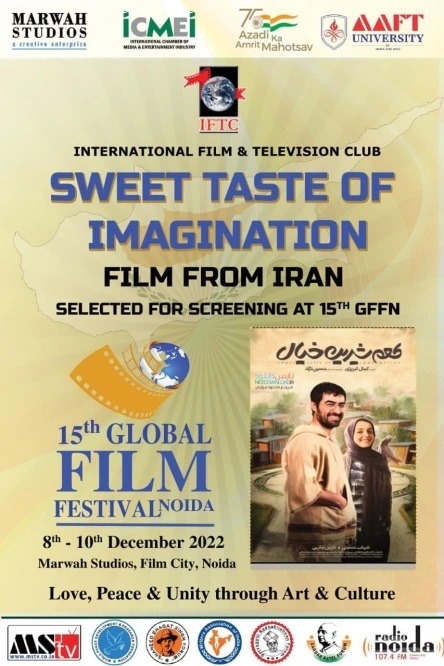
Noida: “We are honoured to announce and present an Award of Distinction to the film from Iran Tilted Sweet Taste of Imagination directed by Kamal Tabrizi and produced by M.A. Hossein Neiad, an entry to 15th Global Film Festival Noida 2022,” said Dr. Sandeep Marwah President of the festival and Marwah Studios at the end of the screening of the film at the festival in a grand function.
The film Sweet Taste of Imagination is a story about an imaginative dreamer of university named Garoos professor who falls in love with a student who resembles her teacher in this manner. Love story is endangered when a business competitor sets Garoos up for unethical behaviour.
The story is written by Naghmeh Samini. The cast includes Shahab Hosseini, Nazanin Bayati, Nader Fallah, Nazanin Farahani, Pariyash Nazarieh and many more. The Cinematography is by Bahram Dehghani and costumes by Majid Lellail.
People associated with Indo Iran Film and Cultural Forum were also present there. The event was supported by International Chamber of Media and Entertainment Industry, Asian Unity Alliance, AAFT University and World Peace Development and Research Foundation.
#Film from Iran Honoured with Award of Distinction at 15th Global Film Festival#Dr. Sandeep Marwah President of AAFT
0 notes
Photo

إنتهت المباراة ٣٥ في كأس العالم قطر ٢٠٢٢ إيران 🇮🇷 و أمريكا 🇺🇸 ملخص الشوط الاول '٣٨ هدف كريستيان بوليسيتش '٤٣ كرت أصفر تايلر آدمز '٤٥ هدف ملغي يونس موسى ملخص الشوط الثاني '٧٧ كرت أصفر مجيد حسيني '٨٣ كرت أصفر حسين كناني '٩٠ كرت أصفر أبوالفضل جلالي Match 35 in FIFA World Cup Qatar 2022 has finished Iran 🇮🇷 Vs. USA 🇺🇸 1st Half Summary '38 Christian Pulisic Goal '43 Tyler Adams Yellow Card '45 Yunus Musah Canceled Goal 2nd Half Summary '77 Majid Hosseini Yellow Card '83 Hossein Kanaani Yellow Card '90 Abolfazl Jalali Yellow Card #FIFAWorldCup2022 #FIFAWorldCup #Qatar #fifa #fifa22 #fifaworldcupqatar2022 #explore #fyp #worldcup #football #neymarjr #ronaldo #sele #qatar2022 #cr #messi #worldcupqualifier #iran #iran🇮🇷 #usa #usa🇺🇸 (at Al Thumama Stadium) https://www.instagram.com/p/ClkGbVKKjqx/?igshid=NGJjMDIxMWI=
#fifaworldcup2022#fifaworldcup#qatar#fifa#fifa22#fifaworldcupqatar2022#explore#fyp#worldcup#football#neymarjr#ronaldo#sele#qatar2022#cr#messi#worldcupqualifier#iran#iran🇮🇷#usa#usa🇺🇸
0 notes
Text
İngiltere'den müthiş başlangıç! İran'a yarım düzine gol...
İngiltere’den müthiş başlangıç! İran’a yarım düzine gol…
Katar’da düzenlenen Dünya Kupası’nda B Grubu ilk maçında İngiltere, Kayserispor’dan Majid Hosseini ve Ali Karimi’nin formasını giydiği İran ile karşılaştı. Khalifa International Stadı’nda oynanan mücadeleyi İngiltere, 6-2 kazandı.
İngilizlere galibiyeti getiren golleri 35’de Bellingham, 43′ ve 62’de Saka, 45+1’de Sterling, 72’de Rashford 90+1’de ise Grealish attı. İran’ın tek sayısını ise 65 ve…

View On WordPress
0 notes
Text
FIFA World Cup: Iran goalkeeper carried off after suffering head injury | Football News - Times of India
FIFA World Cup: Iran goalkeeper carried off after suffering head injury | Football News – Times of India
DOHA: Iran goalkeeper Alireza Beiranvand was substituted early on in their World Cup Group B opener against England on Monday after suffering a head injury. Beiranvand collided horribly with his team mate Hosseini Majid as he tried to deal with a cross and spent several minutes stricken on the turf having treatment. The 30-year-old eventually was surprisingly allowed to continue with blood…
View On WordPress
0 notes
Text
‘Ridiculous’ – Iran manager slammed after concussed goalkeeper is not subbed during World Cup opener vs England
‘Ridiculous’ – Iran manager slammed after concussed goalkeeper is not subbed during World Cup opener vs England
Iran keeper Alireza Beyranvand had a very painful head clash with teammate Majid Hosseini (Photo: BBC)
Jermaine Jenas and Alan Shearer have slammed the decision to keep Iran’s Alireza Beyranvand on the pitch after picking up a head injury during their World Cup opener against England.
Early into Monday’s game, the goalkeeper went to clear a cross from England captain Harry Kane but in doing so…
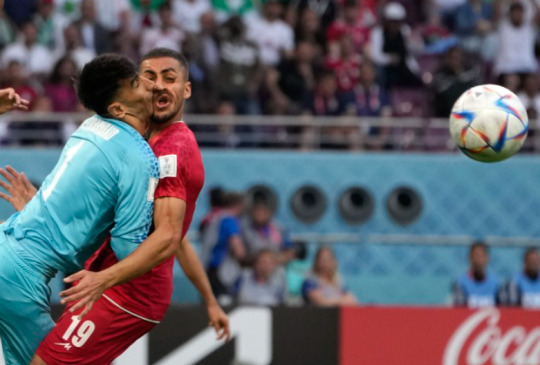
View On WordPress
0 notes
Text
FIFA World Cup: Iran goalkeeper carried off after suffering head injury | Football News - Times of India
FIFA World Cup: Iran goalkeeper carried off after suffering head injury | Football News – Times of India
DOHA: Iran goalkeeper Alireza Beiranvand was substituted early on in their World Cup Group B opener against England on Monday after suffering a head injury. Beiranvand collided horribly with his team mate Hosseini Majid as he tried to deal with a cross and spent several minutes stricken on the turf having treatment.
The action resumes after two long breaks of play, with Iran goalkeeper Alireza…
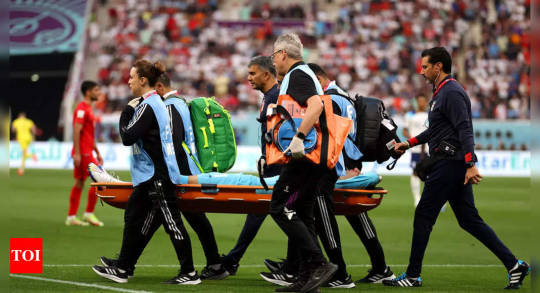
View On WordPress
0 notes
Text
youtube
2 notes
·
View notes
Text
There is not much News coming out of Iran.
Probably Internet is completely shut down.
I will share the Names of people who were announced to be sentenced to Death, but were not at that time. I hope all of them are alive and well.
I request you to Reblog these Names. Please share.
Mohammad Ejma
Mohammad Pasandian
Sajjadimannejad
Mehdisannefarshi
Hazharhamidi
Alirezakafaei
Miladarmoun
Elahe Mohammadi
Niloofar Hamedi
Shoaib Mir Baloch Zehi Rigi
Mohammad Ghobadloo
Mohammad Qobadloo
Ebrahim Naroui
Toomaj Salehi
Farnoush Esmi
Benjamin Gaffari
Mohammad Boroughani
Ayoub Jamal
Mohammad Soltani
Mojgan Valian Zadeh
Jalil Azizpour
Alan Veysi
Bahaledin Veysi
Javad Rouhi
Elham Modaressi
Ava Jahangiri
Paria Faramarzi
Shahin Samadpour
Hamid Gharehasanlou
Farzaneh Gharehasanlou
Manouchehr Mehman-Navaz
Akbar Ghafari
Ebrahim Rigi
Mohsen Rezazadeh Qaraqualou
Saman Yasin
Seyed Mohammad Hosseini
Parmida Mehdipour
Farhad Tahazadeh
Farzad Tahazadeh
Sahand Noor Mohammadzadeh
Mehdi Keshvari
Hossein Hajlou
Abol Fazl Mehri
Hossein Mohammadi
Raha Ajoudani
Arin Farzania
Armin Mehdi Shokrollahi
Amir Mehdi Jaffari
Mahan Sadrat
Saeed Shirazi
Hajar Hamidi
Reza Eslamdoost
Karvan Shahiparvaneh
Shahram Marouf-Moula
Saeed Yaghoubi
Saleh Mir Hashemi
Amir Nasr Azadani
Mohsen Sohrabi
Makan Davari
Majid Kazemi
Hassan Firouzi
Farnaz Alizadeh
Niloufar Shakeri
Soheila Hijab
Hasti Ofogh
Samaneh Fathi
Shaker Behrouz
Parham Parvari
Saman Sayeedi
Elham Shoukdar
Zahara Hamedani
Navab Ebrahimi
Keyvan Mohtadi
Ehsanpirbarnash
Poryajavaheri
Ebrahim Naroui
Mehdi Mohammadi Fard
Mansour Dahmardeh
Kambiz Khorvat
Arshia Takdastan
Vajihe Pari Zanganeh
Amirsartipi
Zahra Nabizadeh
Hossein Ekhtarian
Mohammad Ekhtarian
Amir Mohammad Jafari
Maryam Haqgou
Shahla Abdi
-
I request you to reblog and share.
Women. Life. Freedom.
Freedom for Iran
#Iran#Iranian Revolution#Women Life Freedom#Jin Jiyan Azadi#Zan Zendagi Azadi#Mahsa Amini#Jina Amini#Say her Name#Yalda Aghafzali#Mohsen Shekari#Majid Reza Rahnavard#Mehdi Karami#Azadi Karami#Mohammed Hosseini#Say his Name#Say their Names#Remember their Names#Stop Executions in Iran#Release all Prisoners in Iran#Women's Rights#Human Rights#Human Rights Violations#Help Iran#Save Iran#Free Iran#Freedom for Iran#Share Awareness#Share
44 notes
·
View notes
Photo


#Ehsan Haji Safi#Ali Beiranvand#Mehdi Taremi#Omid Ebrahimi#Saeid Ezatolahi#Ramin Rezaeian#Vahid Amiri#Morteza Pouraliganji#Alireza Jahanbakhsh#Sardar Azmoun#Majid Hosseini#Joao Mario#William Carvalho#Adrien Silva#Rui Patricio#Andre Silva#Jose Fonte#Ricardo Quaresma#Cedric#Cristiano Ronaldo#Ronaldo#Pepe#Raphael Guerreiro#soccer#football#World Cup 2018#fifa world cup 2018#FIFA World Cup#World Cup#WC18
11 notes
·
View notes
Photo
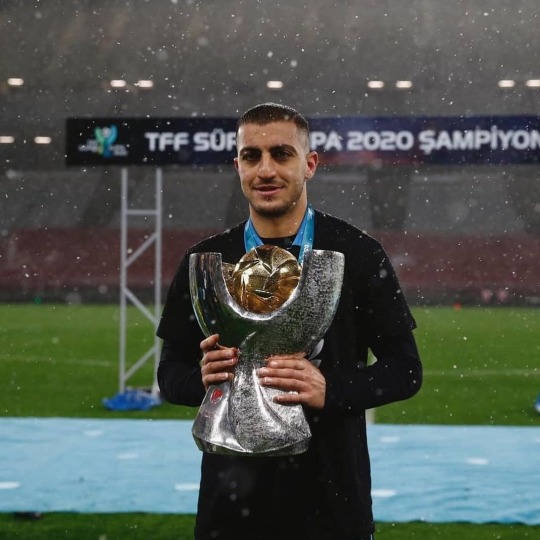
@seyedmajidhosseini5 & @Trabzonspor won the TFF #SüperKupa 🇹🇷 🇮🇷 🏆 . . #GolBezan #TeamMelli #TeamMelliIran #Iran #IranFootball #IranianFootball #AllForTeamMelli #Legioner #Legioners #MajidHosseini #Hosseini #Majid #Trabzonspor #Trabzonspor🔵🔴 #گل_بزن #تیم_ملی #تیم_ملی_ایران #تیم_ملی_فوتبال_ایران #تیم_ملی_فوتبال #ایران #فوتبال_ایرانی #فوتبال_ایران #فوتبال #لژیونر #لژیونرها #اخبار_فوتبال #مجیدحسینی #مجید_حسینی #حسینی https://www.instagram.com/p/CKltlaelVc4/?igshid=zzfr2yxoxqd6
#süperkupa#golbezan#teammelli#teammelliiran#iran#iranfootball#iranianfootball#allforteammelli#legioner#legioners#majidhosseini#hosseini#majid#trabzonspor#trabzonspor🔵🔴#گل_بزن#تیم_ملی#تیم_ملی_ایران#تیم_ملی_فوتبال_ایران#تیم_ملی_فوتبال#ایران#فوتبال_ایرانی#فوتبال_ایران#فوتبال#لژیونر#لژیونرها#اخبار_فوتبال#مجیدحسینی#مجید_حسینی#حسینی
0 notes
Text
Ieri erano tutti virologi, oggi improvvisamente sono tutti esperti di Afghanistan, estremismo islamista e Islam.
Ovviamente ne stanno già approfittando per portare avanti nuove campagne islamofobe, con la scusa di essere preoccupati per il destino delle donne afghane, le quali stanno vivendo una situazione tragica.
Lasciatevi dire che ai talebani non frega nulla della fede, la loro è sete di potere.
Se avessero davvero letto e soprattutto compreso il Corano, non farebbero nulla di ciò che fanno, delle atrocità che mettono in atto.
Oltretutto il Corano è scritto in arabo classico e in Afghanistan si parla il pashtu, quindi ci sta che tanti non capiscano nemmeno tutto quello che c’è scritto (personalmente mi viene sempre in mente un passaggio de “Il cacciatore di aquiloni” di Khaled Hosseini: “mi riferisco a tutti loro. Fregatene di quello che dicono quelle scimmie presuntuose. Non sanno fare altro che contare i grani del rosario e recitare un libro scritto in una lingua che neppure capiscono”).
Usano solo gli ayat (i versetti) che fanno comodo a loro, assieme ad hadith di dubbia origine. Il tutto completamente svincolato dal contesto nel quale sono inseriti.
Ergo, è solo pura strumentalizzazione.
L’Afghanistan è stato per 20 anni il parco giochi militare delle potenze imperialiste occidentali, ancora profondamente intrise di colonialismo e del complesso del “fardello dell’uomo bianco”, le quali non hanno pensato ad altro che ai propri interessi, contribuendo a destabilizzare l’equilibrio del Paese e spianando di fatto la strada ai talebani.
Il conflitto che quest’ultimi portano avanti non ha niente di religioso, ma è geopolitico.
Citando ciò che ho scritto in uno dei miei libri: hanno fatto dell’Islam un loro ostaggio.
Se usate questa tragedia umanitaria per la vostra propaganda e il vostro odio islamofobo, in realtà non ve ne frega niente dell’attuale situazione e del destino delle donne e delle minoranze etniche, religiose o sessuali.
Chi strumentalizza questa tragedia per alimentare la discriminazione e l’islamofobia è miserabile tanto quanto gli estremisti.
Piuttosto che parlare di cose che non sono di vostra competenza, informatevi sulla situazione e su cosa potete fare per aiutare concretamente.
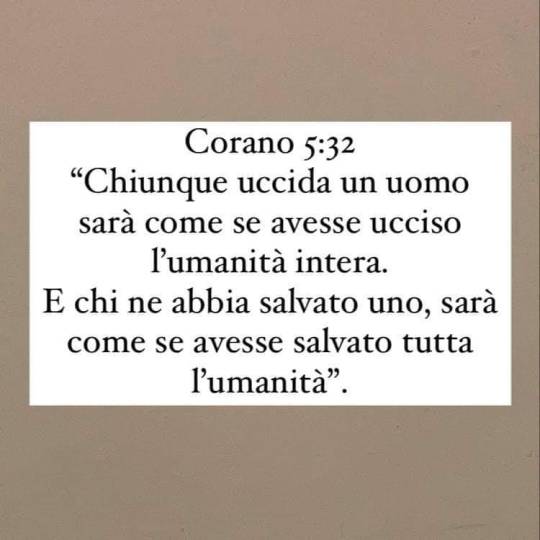
Majid Capovani
14 notes
·
View notes